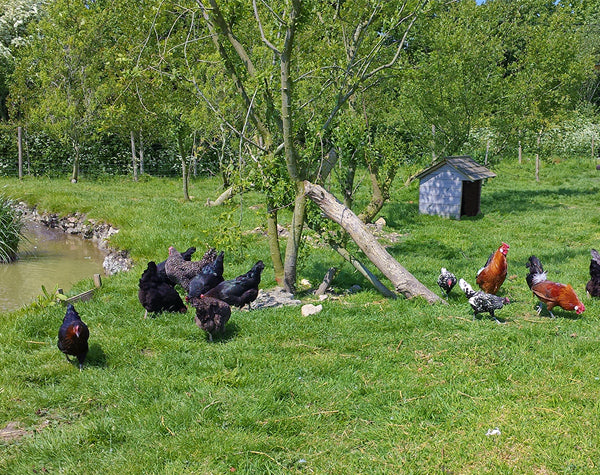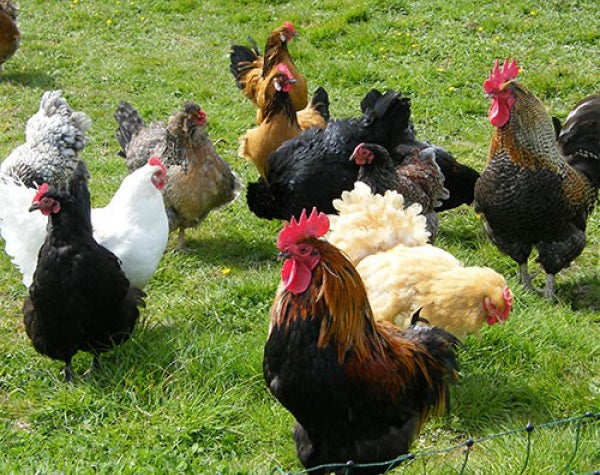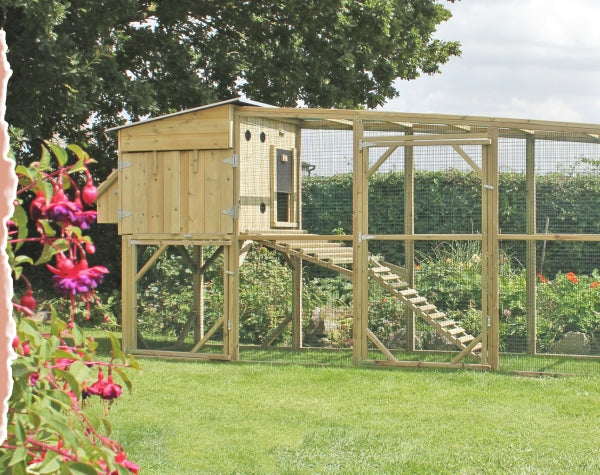What are the best breeds of Chickens?
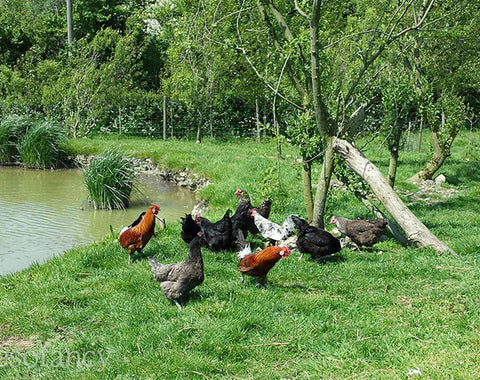
Chickens come in all shapes, sizes, and every colour of the rainbow. Choosing the perfect poultry can be a tricky thing to do.
So, 'which are the best breeds' is a little subjective really. Your questions may be - which type of chicken is best with children? Or, what is the best breed for beginners? Which breed lays most eggs?
When deciding, you should ask yourself the fundamental question, what are you looking for in a bird? If it is eggs (and lots of them) then it’s best to start with a hybrid (see Which hens lay the most eggs). If it’s for exhibiting birds, or as a beautiful-looking pet, perhaps a pom-pommed Poland, fluffy Silkie or the docile Pekin would be best for you.

If the lawn and flowerbeds are your pride and joy, large breeds such as the Brahma (image is our Brucie Brahma), which are less likely to dig due to their voluminous pantaloons, might be the hen for you.
Also, the larger the breed the larger the henhouse needed. And, are you going to keep them within a Run area or are they going to free-range a paddock or your garden?
Pure Breeds are chickens that fulfil a list of features specific to that bird. The best way to think about Pure Breeds in chickens is the same as you would a Pure Breed dog, they have a specific lineage and are recognisable to that breed.
Hybrids are the more commonly known breeds of chicken e.g. plain brown hens. The more robust hybrids are a great option if you are new to chicken keeping as they are often more docile and less temperamental. They are excellent egg producers and rarely go broody.
Deciding on whether you want, or need, a Cockerel is also not a decision to be taken lightly. On the positive, Cockerels often look stunning (see again Brucie above) and they do keep the ladies in order, which prevents hen pecking; on the flip side, they usually make a lot of noise, require more space, they don’t lay eggs, and you don’t need them unless you plan to breed chicks.
Below we describe some of the more popular breeds, some rather more unusual, and many of our Flyte so Fancy birds.
BARNEVELDER

Barneys, as they are affectionately known, are friendly robust birds and are great in a back garden flock. They lay dark brown eggs and will give you 3 to 4 eggs per week. A popular bird due to its lovely temperament, hardy nature, beautiful plumage, and that they will lay throughout the winter.
Originally bred in the Dutch town of Barneveld in the 1800s by crossing a local breed with ‘Oriental’ breeds, like Langshans and Malay, to produce dark brown speckled eggs. To give them their distinctive feathering Wyandottes were added to the mix.
The brown and black laced arrowhead feathers are most popular, but they also come in silver laced, blue laced, chamois, etc. Neck feathers are normally plain. The Cockerel’s feathering is not quite as striking. Barnevelders were recognized as a pure breed in 1923 and classed as ‘soft feathered, heavy breed’. They have yellow legs and skin, and 4 toes. They do not fly well.
Although hardy in most climes, and are not prone to many health issues, they are susceptible to Mareks disease so should be vaccinated at day-old. Otherwise, they love free-ranging, are problem-free health-wise, relatively quiet, rarely go broody, and are non-aggressive.
Eggshell colour: Dark brown speckled
Lays: up to 200 eggs per year
Sizes: Large fowl and Bantam
Colours: Black Laced, Double Laced Silver, Double Laced Blue, Chamois, Silver Blue, White
BLACK ROCK HYBRID

The Black Rock is probably the most popular hybrid breed of egg-laying hen.
It is a cross of the Rhode Island Red and the Barred Plymouth Rock. Both breeds are known for their excellent egg laying and hardy outdoor nature.
Beware of imitations – Crosslee Poultry Farm (Muirfield Hatchery) in Scotland is the only true hatchery to supply Black Rocks to approved distributors in the UK.
Black Rocks are known to be active and energetic, have few health problems, making them popular for commercial producers and back garden keepers alike. They are good foragers (they do like to dig) and their feathers are tight making them hardy for British weather conditions.
Their feathering is black with an almost blue sheen and the neck feathers are generally gold although the amount of gold does vary on each bird. Known as long-lived egg producers, their eggs are light brown in colour, and they will lay around 5 eggs a week for up to 7 years.
Eggshell colour: Light brown
Lays: 250 – 300 eggs per year
Type: Hybrid hen classed as large fowl, light feathered
Colour: Black body with gold neck feathers
BLUEBELL HYBRID

The Bluebell is one of the larger hybrid hens and is a cross (usually) between Blue Marans and Rhode Island Red which produces grey-blue feathered bodies, dark neck feathers and dark legs.
Bluebells are good starter hens for new chicken keepers as they are docile and trouble-free. They are great for free-ranging but can adapt if they have to be confined. As well as this they are good egg layers often laying 5-6 eggs a week. They are known for their friendliness and love of foraging, as a hybrid they rarely become broody.
Eggshell colour: Light brown
Lays: approx. 250 eggs per year
Sizes: Hybrid hen
Colours: Grey-blue
BRAHMA

The King of Chickens, the Brahma is a very large chicken, which doesn't always make them suitable for small gardens, although they do also come as bantams. Image is our Sir Walter Lemon.
A huge placid bird of Asiatic origin, they are from the Brahmaputra region of India where they were originally known as Grey Chittagongs. Their origins are from jungle fowl and Cochins.
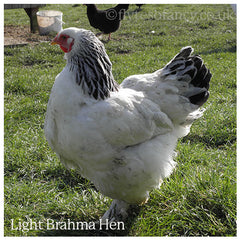
With their famous feathered skirts, they are primarily an ornamental bird, both calm and friendly and rarely make much mess due to their feathery feet.
Their feathered feet can make them susceptible to Scaly Leg Mite, however, the huge underskirt of feathers makes them great broody hens.
As non-flyers they are easily contained and are easily handled, making them a good hen for children.
They are bred in many different colours including Buff, Light, Lemon Pyle, White, Partridge and more.
They can lay around 120 eggs a year of medium size, which are often lightly tinted in shade and appearance.
CALDER RANGER HYBRID

A brown hybrid bird, typical of a free-range egg producing farm.
They are a cross between a Rhode Island Red and a Light Sussex. Also known as trademarked names of Gold Ranger, Gold Star, Red Ranger, Black Tail or Columbian Black Tail.
They will produce as many as 300 to 320 eggs a year.
An easy to keep friendly hen. They can also be kept inside if wanted, where egg production could be slightly higher.
COCHIN

A sedate and ornamental bird, with its imposing colours and feathered feet it was originally a utility bird bred for meat and eggs.
A heavy bird, soft feathered and with fluffy feet they do not fly well and neither do they do much damage to gardens.
Laying roughly 150 to 200 medium-sized eggs a year the colours can go from cream to light brown.
They are a beautiful large fowl and an excellent broody due to their big duvet of feathers.
CREAM LEGBAR HYBRID

This is an autosexing breed of hybrid. This means you can sex the chicks by their head colour, males having rougher spots of colour on their heads which spreads across the body.
They come from cross-breeding of Brown Leghorns, Barred Plymouth Rocks and Araucana in the 1930s.
With their magnificent little crest atop their head, they are inquisitive and often times noisy birds.
The eggs come in shades of blue through green and this hen can lay 180+ a year. The hens are also superb mothers and will foster well.
DORKING

The Dorking is an old utility breed for meat and eggs, introduced to this country by the Romans.
A table bird, it was heavily produced around Dorking in the 19th Century, giving it its name, it is easily discernible by its five-toed feet.
Available as a fowl or bantam, they are docile birds but do like to free-range.
The large single combs can suffer from frost damage in the winter, so precautions such as Vaseline should be taken.
The cock birds can grow very large, but the hens make excellent mothers laying around 150 to 200 good-sized eggs.
DUTCH BANTAM

This is a true bantam breed, there are no large fowls available.
They are an upright and jaunty breed with a short back. The hens' tails are a lovely 'hand of cards' of feathers.
The cock bird is like a large rooster in miniature, in particular, he has distinctive white ears.
The males can be vocal and somewhat feisty, however, due to their size, little damage is done.
A breed that is easy to tame, they breed well, produce small white eggs and make great mother hens.
LAVENDER ARAUCANA

The Araucana breed originates from Chile, South America. They are the only breed to have tufts of feathers over their ears.
They lay lots of blue, strong shelled, eggs. The blue colour goes all the way through the shell.
All blue egg layers have some Araucana in their ancestry i.e. if you cross an Araucana with a Maran, you get a green/blue egg.
This hen will lay somewhere between 170 to 200 eggs a year.
They have a fluffy ruff-like collar around the face, feathers around their ears and no wattles. This hen is lovely to look at, available in many colours but particularly popular in Lavender.
This bird comes as both a large fowl or a bantam and its eggs are relatively large compared with its size.
LIGHT SUSSEX

This is a dual-purpose utility breed originating in England from Roman times.
Available as a large fowl or bantam, the breed also comes in many different colours. There are 8 recognised colours - brown, buff, coronation, light, red, silver, speckled and white.
These birds are alert but docile and highly adaptable, happily free-ranging they are great foragers but will also thrive in confined conditions.
The cock birds, however, are large and often aggressive. The hens go broody and make great mothers.
They lay 240 to 260 medium/large brown eggs a year.
MARANS

Marans are a heavy poultry breed famed for laying deep glossy brown eggs (although not all Marans lay dark brown eggs). If the genetic strain is right, the eggs can be from dark brown to deep chocolate brown. Other breeds that lay dark brown eggs are Welsummer and Barnevelders.
Originating in the French port town of Marans (SW France), the breed was developed in the early 1900s by crossing local game birds, possibly with Croad Langshans and Faverolles. Early breeders were trying for dark brown eggs so several types emerged. French Marans have feathered legs, but English Marans have clean legs. The breed was brought to England in 1929 and standardised by the mid-1930s.
Good pure breed Marans can be hard to find as they have often been mixed with other breeds to give autosexing chicks. Marans rarely go broody so, an incubator would be needed for breeding. Do be aware of the potential cross-breeding in the strain you have and select the darkest brown eggs.
Marans are slow-growing birds, and although historically a utility bird, they are not used as meat birds today as they take so long to grow. A strong, wide, hardy bird so suitable in northern European climates. They have white skin and pink-grey legs. The large combs can make them prone to frostbite.
Temperament can vary, mainly docile and friendly, but some types are skittish. They are not keen on being cuddled.
Eggshell colour: Dark brown (and thick-shelled)
Lays: up to 200 eggs per year
Sizes: Large fowl and Bantam
Colours: Copper Black, Dark Cuckoo, Black, Black-Tailed Buff, Copper Blue, Golden Cuckoo, Silver Cuckoo, Birchen, White, Wheaten (not all of these are recognised by the UK Standards).
Note – because we get asked – the breed originates in the town of Marans, SW France. It is always spelt Marans with an ‘s’. One is a Marans, and two are Marans. The English pronounce it 'Mah-ran' with a silent ‘s’, although the French elegantly roll the ‘r’ and pronounce it 'Muh-ran'. Think of it like Walrus ... one Walrus is not a Walru.
MARSH DAISY

Originating in Lancashire in the 19th Century, the birds' rose comb is said to resemble the flower of the marsh daisy.
A lightweight slow-growing and frugal eater of a fowl, it is however a hardy bird that loves free-ranging and forages well.
It is a calm bird but can fly well. Its rose comb, green legs and attractive colouring all combine to produce a striking bird.
The eggs are fairly small and lightly tinted and you can expect somewhere in the region of 100 to 150 a year.
OLD ENGLISH GAME

Descended from the old pit game birds used for cockfighting, they are noisy, active, intolerant of other birds and flighty.
Cockerels can also not be kept together as they will fight to the death.
They are a hardy breed that does not like confinement. They are good fliers and given the chance will roost in trees.
Available in many colours and both large bird and bantam, the mothers make good brooders.
You can expect 100 to 150 medium-sized cream-tinted eggs a year from this breed.
ORPINGTON

The Orpington is a quintessentially English breed. It is a large bird, crossbred by William Cook of Orpington (Kent) in the late 1800s to make the Black Orpington. Its dark plumage usefully masked the dirt and soot prevalent in city allotments in the 19th century.
The Orpington was bred originally as a utility bird to provide meat and eggs, they were used commercially as brooding hens due to their habit of going broody often, and they are good mothers. Today they are more bred as exhibit birds and the Buff has become the most popular. They were one of the late Queen Elizabeth, the Queen Mother’s, favourites.
As soft, very feathery, birds they can go soggy very quickly and do not thrive in damp or muddy conditions. In fact, they are big balls of fluffy feathers. A tame and easily handled bird, they are great birds if you have children helping with their care. Even the cockerels are quite docile.
Easy maintenance bird but do check regularly for lice amongst their voluminous feathers.
Eggshell colour: Light brown
Lays: 170 - 200 eggs per year
Sizes: Large fowl and Bantam
Colours: Buff, Black, Lavender, Blue, Birchen, Chocolate, Cuckoo, Jubilee, Lemon Cuckoo, Partridge, Gold Laced.
PEKIN BANTAM

An ornamental True Bantam, this cuddly ball of feathers can be incredibly tame, especially if there is a treat involved.
They lay few eggs themselves, roughly 95 small cream eggs a year and can go broody easily, but are great mothers.
This makes them very useful for hatching the eggs of other hens. Long skirts of feathers mean they need somewhere to dry off.
These birds were originally known as Cochin Bantams but are now a separate breed. They are great for gardens causing hardly any damage, however, they do not do well in wet or muddy conditions owing to their fluffy underskirts.
An important characteristic for the breed is that the body is centred forwards with the head lower than the tail. They are a docile breed and can be handled by children with ease, the cockerel however will still be defensive of the hens, it's his job.
Eggshell colour: Cream/brown
Lays: 100 - 150 eggs per year
Sizes: Small Bantam
Colours: lavender, blue, silver partridge, red partridge, cuckoo, mottled, buff, black, white (and more)
POLAND

The Poland is an old European breed with a distinguishing 'top hat' of feathers. Originally from The Netherlands (although there is debate about this), it is possible that the name ‘Poland’ comes from the Dutch word ‘pol’ meaning large head.
Polands were initially imported for their white egg-laying but were overtaken by other breeds, like the Leghorn. Today they are primarily bred as ornamental birds. The appeal is their striking appearance with a large topknot of feathers that cascade over their head and face. In the female, the topknot feathers form a neat ball, whilst the male's headdress falls like a shawl around his head.
Although Polands are a hardy breed, they do not like cold or damp conditions. They can be kept in an outdoor henhouse all year providing shelter is also available. They do need a great deal of attention and are easily spooked due to their limited vision. But, once used to their surroundings, they are friendly and docile.
Problems like lice can be more common in feathery birds like Polands. Take extra care with feeders and drinkers to ensure the crest does not become soiled.
Polands are difficult to breed naturally as the hens rarely go broody. If breeding, an incubator would be best.
Eggshell colour: White
Size: Large Fowl and Bantams
Lays: Approx. 150 eggs per year
Colours: Cuckoo, White-Crested Black, White-Crested Blue, White-Crested Cuckoo, Black, Blue, White, Splash, Chamois, Gold & Silver Laced.
RHODE ISLAND RED

The Rhode Island Red was developed in Rhode Island (New England) during the 1890s by Isaac Wilbour by crossing breeds like Malay, Java, Cochin, and Leghorn to create a recognised dual-purpose breed. The Rhode Island Red is still the state bird of Rhode Island.
After Sidney Risdon brought some eggs back to England with him in 1903, the Rhode Island Red quickly became popular and is still one of the most well-known breeds in the world and was accepted by the British Poultry Society as a breed in 1909.
Bred originally as a utility bird, the Rhode Island Red is known for its egg production. By the 1940s, breeders began to favour their prolific egg-laying capabilities and selectively bred them specifically for egg-laying. This sought-after characteristic makes them a popular breed base for many hybrid hens today.
Its body should look like a longish ‘brick’, rectangular and solid. Feathers are hardy, and the colour varies from rich mahogany to dark rust, although the tail often has black tips. Its skin is a yellow colour, as are its legs and beak.
Generally speaking, they are placid and hardy, but chatty and active. ‘Rhodies’ are a very popular breed; are docile towards humans and make the perfect pet. Cockerels, however, are aggressive, especially during the breeding season and when paired with other males.
They prefer free-ranging and love to forage, rarely go broody, are not bothered by climate, and have a healthy constitution.
Eggshell colour: Light brown
Lays: up to 300 eggs per year
Sizes: Large fowl and Bantam
Colours: Mahogany Brown (despite the name, the Rhode Island White are a separate breed)
SEBRIGHT

The Sebright Bantam is a small and unique breed from the early 1800s in England. A ‘true bantam’ developed by Sir John Sebright, it is believed to be a cross of one of his game birds with a Nankin bantam.
They are very symmetrical and compact in appearance and very distinctive. They have a rose comb and short, tight feathers that give them a smooth, polished look.
Sebrights are known for their hardiness and ability to tolerate cold temperatures. They lay a good amount of small white eggs but are not considered heavy layers. They are usually kept for their beauty and ornamental value, not for meat.
With their small size and active nature, they are easy to handle and well-suited to life in a small garden or even in a confined space such as a coop and small run.
Eggs: Small white
Lays: up to 80 eggs per year
Sizes: True Bantam
Colours: Gold and Silver
SILKIE

Available as both a bantam and large fowl, it has fluffy as opposed to feathery plumage, dark skin, blue earlobes and five toes to each foot.
Due to its docile temperament, it makes an excellent broody bird as well as a mother to its own chicks.
Owing to their unusual plumage they are not hardy, they suffer from both cold and damp and can go downhill very quickly if not fussed over. They are also susceptible to being bullied by other hens as they do not particularly stand up for themselves.
They can lay roughly 100 eggs a year of a medium to small size and cream in colour, however, this is often interrupted by them going broody.
SILVER SPANGLED HAMBURG

Laying china white eggs, Hamburgs are a rarer breed regarded as a good quality egg producer.
An active bird, capable of flight, they are a hardy bird that comes in many different varieties.
The cockerels can be noisy and aggressive, however, as a breed, they enjoy free-ranging and foraging over large areas.
Available as either a bantam or large fowl, they come in several colours. They are typical central European birds, frugal eaters and self-sufficient.
SPECKLEDY HYBRID

The Speckledy Hen is a hybrid chicken breed and a prolific egg layer.
They closely resemble their Marans ancestors in looks but are crossed with Rhode Island Red to create a robust bird with egg-laying abilities that makes it highly sought after.
It can be difficult to tell them apart from Marans but they do tend to have lighter grey feathers around the neck. Eggs are normally chestnut brown, or speckled, although some do lay lighter shelled eggs.
Bred specifically for free-ranging, it is non-aggressive and sociable. These birds have a natural foraging ability.
Dependable layers of up to 260+ eggs a year they can also make great foster mums.
WELSUMMER

Originally from the village of Wellsumm in the Netherlands, this bird comes in both a bantam and a large fowl.
Technically it is a light breed however it is a good-sized bird that is a good forager and loves free-ranging.
The hen is friendly and easily handled and if desired, can be kept in confinement.
The hens do go broody, however, do not make good mothers. The chicks of this breed are autosexing.
It lays large dark eggs, around 160 a year, some can be mottled with brown spots.
WHITE STAR HYBRID

Probably the best breed for egg laying.
The White Star is the commercial version of a White Leghorn - a most prolific egg layer - and a hardy Rhode Island Red.
It is a hybrid of Dutch origin and is a small flighty bird with a bright red comb and white feathers. Very lively, hardy and independently minded, it is happy to take care of itself and just keep laying eggs.
Its vivid red comb and snowy white feathers come from its original Leghorn stock which were introduced to the UK in the late 1800s.
This bird is a frugal eater and puts all its energy into laying. As such you can get as many as 320 white eggs a year, however, it is not as long-lived as other hybrids.
WYANDOTTE

Originating in the United States, this breed is available as both a bantam or large fowl.
A medium-sized bird with a rose comb, they will be happy both free-ranging or will thrive in run conditions. They are vocal birds but also very, very friendly.
Wyandotte hens make very good mothers but almost always go broody once her clutch is laid. They require extra care during this time as they can stay inside all the time, even to the point of not feeding.
They lay between 200 to 240 eggs per year of a pale brown or tan colour.
Further reading ...
There are almost 100 Pure Breed Chickens in the UK, that are officially recognised to British Poultry Standards, which are set by the Poultry Club of Great Britain.
It's more difficult to number the Hybrid breeds as they are registered names with the hatchery that bred them, and sometimes the same cross can have a different name but only a very slight difference in features.
For more details and reading about the eggs hens lay, visit How many eggs does a hen lay? and also, for the biology, The Anatomy of an Egg.
A very comprehensive list of breeds can be found at poultrykeeper.com
- - - -
Choosing Your Chickens ©Flyte so Fancy 2012. Updated 2022. Author: Anne Weymouth (Director, Flyte so Fancy Ltd). Reproduction of part or all of this text is only possible with the express permission of Flyte so Fancy Ltd

